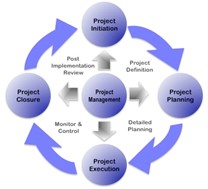While we would like to think that all management is science, and would like to go after all management issues scientifically, sometimes it is using the management arts that will help us solve some of the key issues.
What is Project Management? Well, the Project Management Institute says that Project Management is “the application of knowledge, skills and techniques to execute projects effectively and efficiently. It’s a strategic competency for organizations, enabling them to tie project results to business goals — and thus, better compete in their markets.” Good of them to have come out with a definition for the un-definable!
Picture Source: 4ditsolutions.com
By the way, many publications and organizations go to great lengths to tell you how Project Management is different from Program Management. They say that a Program Manager has to see the big picture (which apparently is different from the small picture) and understand that a Program delivers benefits to the customer incrementally while a Project delivers benefits in a big bang.
Of course, there are some key differences between a Project and a Program and you need to keep these in mind whether you are running a Project or a Program. See https://pm-powerconsulting.com/?p=121
However, it will not harm a Project Manager if he sees the big picture! In fact it will help in two ways: one, it helps you execute your project better if you know where your project fits in in the big picture; two, it helps you get noticed by your management, which will help you get your promotion to Program Manager earlier! See https://pm-powerconsulting.com/?p=283
However we define it, one key aspect of Project Management is delivery.
Picture Source: repco.in
This includes the Project Life Cycle like Planning, Execution, Governance, Pre-Sales and Project Success Metrics. These could be tackled through some scientific methods. Take Project Metrics for instance. Metrics like gross margin, productivity and such-like can be measured directly and reported on. If these numbers look good, the Project is doing well. If they don’t, the Project Manager is in for a hauling over the coals. There are also have metrics for things like customer satisfaction which are not so easily measurable. You could send out a customer satisfaction survey and hope that the customer and their users fill out the survey objectively. But they may not; and then you are left with very “subjective” objective measurements.
But another key aspect of Project Management is the “soft” areas like leadership, enablement, people management and customer relationship and interface. Unfortunately there are no metrics for leadership. What numbers can you put on negotiation? They say you should strive for win-win. What is that? A score of one all?
Negotiation may ultimately hinge on convincing the other fella that he also won. Is there a method to doing this? Any numbers? Another leadership area is influencing. For those of us who find in difficult to measure whether we have influenced even our own children, measuring our influencing results on tough customers is not easy. The same lack of science goes for implementing the other leadership areas like coaching, problem solving, communicating, empowering etc.
So what do we do? What is the answer? A lot of Project Management deals with things you can’t hold in your hands. So Project Management is some science and a lot of art. You either have many of these soft skills or you don’t. But those red-necks reading this don’t have to despair. These skills can be learned and gained from experience. There are also courses that may help point you in the right direction. Finally it is how a Project Manager applies what he has learned that is crucial.



